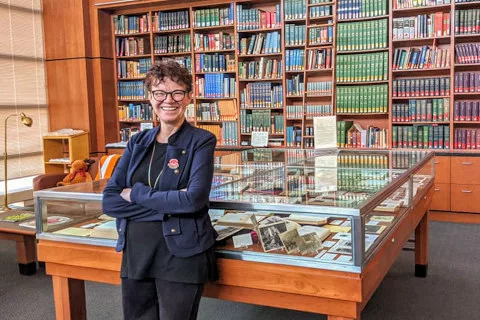As a curator and public historian in a health sciences environment, it was imperative that I bring attention to the history of World War I and the influenza pandemic of 1918 during the 100-year anniversary of those impactful realities.
I opened the exhibition, “Staggering Losses: WWI and the Influenza Pandemic of 1918,” in November 2018 at the University of Wisconsin–Madison’s Ebling Library in the Health Sciences Learning Center. Due to its popularity, the exhibition was extended three times, until it ironically became shuttered by a pandemic.
There are many ways to approach the storytelling inherent in exhibition work. Research in the amazing resources at Ebling and other campus collections is a double-edged sword. So much information to read and sift through! During the nine months of research in myriad directions — ambulance-driver stories, plastic-surgery scenarios, wound-management techniques, diseases contracted in the trenches, nurses’ chronicles, physician discoveries in antisepsis, attempts at treating the flu, mules wearing gas masks — I wondered, how could I possibly portray these accounts in just 13 glass cases?
I came away with this: How do I convey the loss? Seventeen million people died in WWI, and between 37 and 40 million were injured. Another 650,000 died in the United States from the erroneously named Spanish Flu, adding to the 20 to 50 million (some suggest 100 million) who died worldwide.

The pandemic started in March 1918, ebbed in the summer and peaked during the following fall and early winter. The statistics were numbing, staggering.
These losses went beyond lives and limbs, into livelihoods, relationships, future children, artistic talents, education, mental health and inquiring minds; a loss of a generation of primarily men, but also women. There was the loss of opportunity and inclusion, as Native American code talkers, African American physicians and Latino troops who contributed to the American effort came home and became victims of Jim Crow laws and other restrictive political certainties and social agendas.
I did what I traditionally do. I drilled down to singular people whose stories could represent the hundreds, thousands, millions of people who had lost their lives or saved the lives of others. While I anticipated interest, I did not realize the power inherent in those 100-year-old stories.
Visitors of all ages wrote in the guest book or sought me out. They’d lean into the cases, point at the clippings, photographs and postcards, and speak reverently, “My grandmother died from the flu, leaving four children.” “My great-granddad had gotten a new job, he died from the flu; his young son, my grandpa, had to work to support my great-grandma.” “My grandpa was gassed in the trenches and never recovered.”
In that hallowed space, they remembered family members they had not thought about for as long as decades. My work had transported them home, and in that moment, they recalled someone whose loss had created a cascading effect on their family history.
Based on the last sentence of my prescient exhibition essay, suggesting that a new global outbreak might make 1918 look like child’s play, I recall thinking, if something like this happens again, we should do all we can to quell the loss.
Our world is very different than it was then in terms of its robust worldwide travel, global supply chain and epidemiological record keeping. Medical treatment is more sophisticated, including established isolation protocols, the availability of antibiotics and antivirals, and the existence of specialists in respiratory care and infectious diseases. Yet, in terms of the approach to the spread of the virus — in 1918, an H1N1, in 2020, the novel coronavirus — the dynamic includes the important interplay between medicine and public health in caring for people and populations.
As of summer 2020, I do not believe anyone is suggesting that COVID-19 will approach the number of people who died in the United States in 1918, though many wonder, as we did over 100 years ago, whether it will have a second wave in the fall. Still, no one knows how the Black Lives Matter protests and the phased return to physical gatherings worldwide will affect the numbers. Stay home as able, wash hands, resist public spitting, mask effectively and do not gather in groups. This was basic, good advice in 1918, and it remains good, albeit inconvenient, advice now.
Till we are able to meet again …
Micaela Sullivan-Fowler, MS, MA
UW–Madison Ebling Library Curator of Rare Books and Special Collections
History of the Health Sciences Librarian
Head of Marketing and Communications
Distinguished Academic Librarian
micaela.sullivan-fowler@wisc.edu